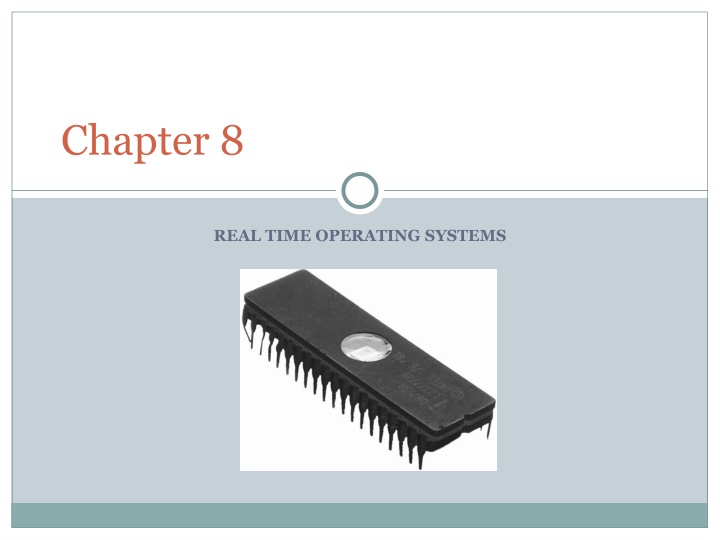
Understanding Real-Time Operating Systems and Tasks
Explore the world of real-time operating systems (RTOS) and tasks, where performance is judged based on time. Learn about the differences between real-time systems and embedded systems, examples of systems with real-time tasks, and essential terms like release time and deadline. Discover the types of real-time tasks and the importance of meeting deadlines in hard real-time systems.
Download Presentation

Please find below an Image/Link to download the presentation.
The content on the website is provided AS IS for your information and personal use only. It may not be sold, licensed, or shared on other websites without obtaining consent from the author. If you encounter any issues during the download, it is possible that the publisher has removed the file from their server.
You are allowed to download the files provided on this website for personal or commercial use, subject to the condition that they are used lawfully. All files are the property of their respective owners.
The content on the website is provided AS IS for your information and personal use only. It may not be sold, licensed, or shared on other websites without obtaining consent from the author.
E N D
Presentation Transcript
Chapter 8 REAL TIME OPERATING SYSTEMS
Real-time Tasks What is Real Time? Simply, the time measured by physical clock. Anything is real time means it has direct relation with actual time. Real time task: Performance is judged on basis of time. Correct result = correct output + correct time Incorrect timing of result leads to : System failure OR Reduced QoS
Examples of systems with real time tasks Process control in industrial plants Robotics Air traffic control Telecommunications Weapon guidance system Medical diagnostic and life-support systems Automobile engine control systems Anti-lock braking systems Real-time data bases
Are real-time systems and embedded systems the same? No, embedded systems are systems designed for a specific set of applications. When such a system requires time constrained operation, it becomes a real-time embedded system.
Terms i) Release time (or ready time) lTask is ready/ eligible for execution ii) Scheduling time Time required to allow the task for execution iii) Completion time lInstance at which task is completed iv) Deadline lMaximum time at which task must be completed otherwise it fails
Terms v) Run time - ? vi) Lateness (completion time deadline ) - +ve lateness is tardiness - -ve lateness is earliness vii) Laxity (slack time) -Amount of time by which task can miss deadline
Scheme of a Time Constrained Task Execution RT Apps are the set of tasks that are scheduled
Types of Real Time Task For a Hard real-time system, if the system fails to meet the deadline even once the system is considered to have Failed. Examples- ?
Types of Real Time Task Soft real-time system, even if the system fails to meet the deadline, possibly more than once (i.e. for multiple requests), the system is not considered to have failed. But, in this case the results of the requests are not worthless value for a result after its deadline, is not zero, rather it degrades as time passes after the deadline. Example - ??
Firm Real Time Task Firm real-time system, even if the system fails to meet the deadline, possibly more than once (i.e. for multiple requests), the system is not considered to have failed. Also, the responses for the requests (replies to a query, result of a task, etc.) are worthless once the deadline for that particular request has passed (The usefulness of a result is zero after its deadline). Example ?
Real-time Systems A real-time system is composed of many tasks, but there should be at least one task which can be categorized as one of the above three types (hard, soft or firm).
Periodic Real Time Tasks The period is the amount of time between each iteration of a regularly repeated task. Such repeated tasks are called periodic tasks. Example Every periodic task has to be finished within the defined period. It does not mean that a real-time system has to act fast.
Aperiodic Real Time Tasks Aperiodic tasks respond to randomly arriving events. Is a stream of jobs arriving at irregular intervals. Each task can arrive at any time Examples
Sporadic Tasks A sporadic task is an aperiodic task with a hard deadline and a minimum inter-arrival time (between two such tasks). Without a minimum inter-arrival time restriction, it is impossible to guarantee that a deadline of a sporadic task would always be me. The jobs can arrive irregularly, but they have minimum inter- arrival time. Example
Real-time Operating Systems Do embedded systems need an operating system?
Real-time Operating Systems In general, an operating system (OS) is responsible for managing the hardware resources of a computer and hosting applications that run on the computer. An RTOS performs these tasks, but is also specially designed to run applications with very precise timing and a high degree of reliability.
Static Priority scheduling Non-preemptive Scheduling Preemptive Priority-based Execution
Dynamic Priority This allows priority to be changed at run time, and so scheduling requires more computation. Here also pre-emption may or may not be used.
The Earliest Deadline First Algorithm This belongs to a class of dynamic priority allocation methods. Here the priority of tasks changes at run time. At any instant, the highest priority task is one that has the closest deadline. Tasks that cannot be scheduled by the RM algorithm (because of high CPU utilization) can be scheduled by this method.
Qualities of a Good RTOS i) Performance ii) Reliability iii) Compactness iv) Scalability
